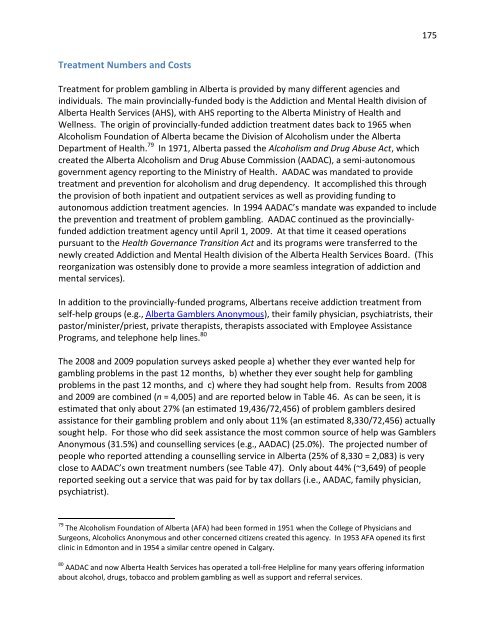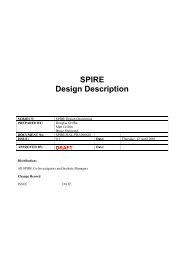gambling in alberta - Research Services - University of Lethbridge
gambling in alberta - Research Services - University of Lethbridge
gambling in alberta - Research Services - University of Lethbridge
Create successful ePaper yourself
Turn your PDF publications into a flip-book with our unique Google optimized e-Paper software.
Treatment Numbers and Costs<br />
Treatment for problem <strong>gambl<strong>in</strong>g</strong> <strong>in</strong> Alberta is provided by many different agencies and<br />
<strong>in</strong>dividuals. The ma<strong>in</strong> prov<strong>in</strong>cially-funded body is the Addiction and Mental Health division <strong>of</strong><br />
Alberta Health <strong>Services</strong> (AHS), with AHS report<strong>in</strong>g to the Alberta M<strong>in</strong>istry <strong>of</strong> Health and<br />
Wellness. The orig<strong>in</strong> <strong>of</strong> prov<strong>in</strong>cially-funded addiction treatment dates back to 1965 when<br />
Alcoholism Foundation <strong>of</strong> Alberta became the Division <strong>of</strong> Alcoholism under the Alberta<br />
Department <strong>of</strong> Health. 79 In 1971, Alberta passed the Alcoholism and Drug Abuse Act, which<br />
created the Alberta Alcoholism and Drug Abuse Commission (AADAC), a semi-autonomous<br />
government agency report<strong>in</strong>g to the M<strong>in</strong>istry <strong>of</strong> Health. AADAC was mandated to provide<br />
treatment and prevention for alcoholism and drug dependency. It accomplished this through<br />
the provision <strong>of</strong> both <strong>in</strong>patient and outpatient services as well as provid<strong>in</strong>g fund<strong>in</strong>g to<br />
autonomous addiction treatment agencies. In 1994 AADAC’s mandate was expanded to <strong>in</strong>clude<br />
the prevention and treatment <strong>of</strong> problem <strong>gambl<strong>in</strong>g</strong>. AADAC cont<strong>in</strong>ued as the prov<strong>in</strong>ciallyfunded<br />
addiction treatment agency until April 1, 2009. At that time it ceased operations<br />
pursuant to the Health Governance Transition Act and its programs were transferred to the<br />
newly created Addiction and Mental Health division <strong>of</strong> the Alberta Health <strong>Services</strong> Board. (This<br />
reorganization was ostensibly done to provide a more seamless <strong>in</strong>tegration <strong>of</strong> addiction and<br />
mental services).<br />
In addition to the prov<strong>in</strong>cially-funded programs, Albertans receive addiction treatment from<br />
self-help groups (e.g., Alberta Gamblers Anonymous), their family physician, psychiatrists, their<br />
pastor/m<strong>in</strong>ister/priest, private therapists, therapists associated with Employee Assistance<br />
Programs, and telephone help l<strong>in</strong>es. 80<br />
The 2008 and 2009 population surveys asked people a) whether they ever wanted help for<br />
<strong>gambl<strong>in</strong>g</strong> problems <strong>in</strong> the past 12 months, b) whether they ever sought help for <strong>gambl<strong>in</strong>g</strong><br />
problems <strong>in</strong> the past 12 months, and c) where they had sought help from. Results from 2008<br />
and 2009 are comb<strong>in</strong>ed (n = 4,005) and are reported below <strong>in</strong> Table 46. As can be seen, it is<br />
estimated that only about 27% (an estimated 19,436/72,456) <strong>of</strong> problem gamblers desired<br />
assistance for their <strong>gambl<strong>in</strong>g</strong> problem and only about 11% (an estimated 8,330/72,456) actually<br />
sought help. For those who did seek assistance the most common source <strong>of</strong> help was Gamblers<br />
Anonymous (31.5%) and counsell<strong>in</strong>g services (e.g., AADAC) (25.0%). The projected number <strong>of</strong><br />
people who reported attend<strong>in</strong>g a counsell<strong>in</strong>g service <strong>in</strong> Alberta (25% <strong>of</strong> 8,330 = 2,083) is very<br />
close to AADAC’s own treatment numbers (see Table 47). Only about 44% (~3,649) <strong>of</strong> people<br />
reported seek<strong>in</strong>g out a service that was paid for by tax dollars (i.e., AADAC, family physician,<br />
psychiatrist).<br />
79 The Alcoholism Foundation <strong>of</strong> Alberta (AFA) had been formed <strong>in</strong> 1951 when the College <strong>of</strong> Physicians and<br />
Surgeons, Alcoholics Anonymous and other concerned citizens created this agency. In 1953 AFA opened its first<br />
cl<strong>in</strong>ic <strong>in</strong> Edmonton and <strong>in</strong> 1954 a similar centre opened <strong>in</strong> Calgary.<br />
80 AADAC and now Alberta Health <strong>Services</strong> has operated a toll-free Helpl<strong>in</strong>e for many years <strong>of</strong>fer<strong>in</strong>g <strong>in</strong>formation<br />
about alcohol, drugs, tobacco and problem <strong>gambl<strong>in</strong>g</strong> as well as support and referral services.<br />
175
















